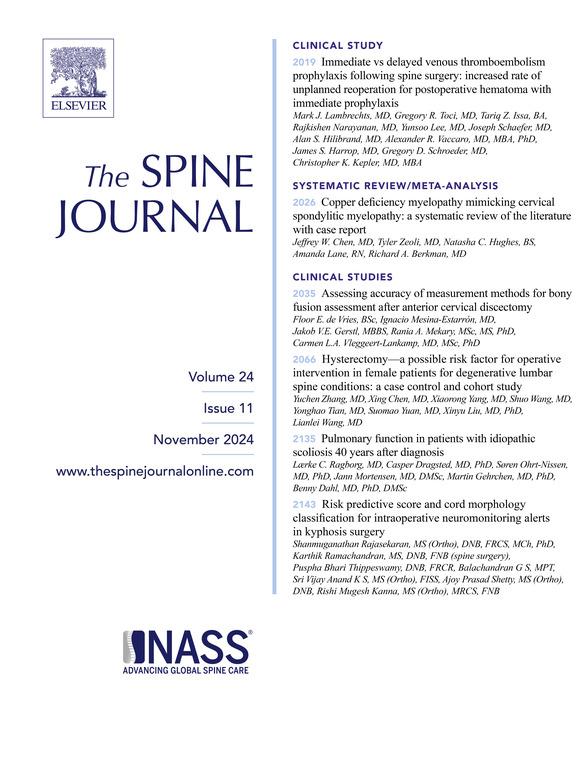39. Effect of semaglutide on 90-day and 2-year surgical and medical complications in diabetic patients undergoing anterior cervical discectomy and fusion
IF 4.7
1区 医学
Q1 CLINICAL NEUROLOGY
引用次数: 0
Abstract
BACKGROUND CONTEXT
Semaglutide, a glucagon-like peptide-1 receptor agonist, has shown efficacy in improving glycemic control and promoting weight reduction in diabetic patients. However, its impact on postoperative outcomes, particularly in the context of spinal surgeries, remains uncertain. While studies on lumbar fusion procedures have yielded mixed results, some suggest that semaglutide may influence bone turnover and muscle mass, which could affect the healing process following spinal fusion. One study indicated an increased risk of requiring additional surgeries post-transforaminal lumbar interbody fusion (TLIF). In contrast, others noted reduced complications following single-level posterior lumbar fusion, including fewer emergency department visits and adverse events. These inconsistencies point to the need for further research to clarify the effects of semaglutide on surgical outcomes in spinal fusion procedures, specifically in the context of anterior cervical discectomy and fusion (ACDF).
PURPOSE
The purpose of this study is to evaluate the impact of semaglutide on 90-day and 2-year surgical and medical complications in diabetic patients undergoing ACDF.
STUDY DESIGN/SETTING
A retrospective cohort study.
PATIENT SAMPLE
N/A
OUTCOME MEASURES
N/A
METHODS
A retrospective cohort study was conducted utilizing the TriNetX research network, a comprehensive healthcare database. Diabetic patients undergoing ACDF were divided into two groups based on their use of semaglutide: Cohort 1 (patients prescribed semaglutide at the time of surgery) and Cohort 2 (patients with no history of semaglutide use). Propensity score matching was applied to balance the two groups' baseline demographic and clinical characteristics. Surgical and medical outcomes, including both early (90-day) and long-term (2-year) complications, were compared between the two cohorts. The primary outcomes assessed were major medical and surgical complications, and the risk ratios (RR) were calculated for each complication at both 90-day and 2-year intervals.
RESULTS
At the 90-day postoperative mark, no significant differences were found between the two groups for any of the complications analyzed. However, at the 2-year follow-up, semaglutide use was associated with a significant reduction in three major complications: mortality, pseudarthrosis, and general postoperative mechanical complications. Specifically, semaglutide use was linked to lower odds of mortality (2.6% vs 5.2%, RR = 0.487, 95% CI = 0.253 - 0.935, P = 0.028), a decrease in pseudarthrosis rates (6.7% vs 12.9%, RR = 0.487, 95% CI = 0.319 - 0.743, P = 0.001), and a reduction in general post-operative mechanical complications (11.4% vs 17.8%, RR = 0.596, 95% CI = 0.421 - 0.843, P = 0.003).
CONCLUSIONS
The use of semaglutide in diabetic patients undergoing ACDF was associated with a significant reduction in mortality, pseudarthrosis, and general postoperative mechanical complications at 2 years. These findings suggest that semaglutide may offer protective benefits for patients undergoing cervical spine surgery, particularly in terms of long-term recovery and complication reduction. Although no significant differences were observed in 90-day complications, the 2-year results indicate that semaglutide could play an important role in improving surgical outcomes. Further prospective studies are necessary to confirm these findings and explore the broader impact of semaglutide on spinal fusion procedures.
FDA Device/Drug Status
Semaglutide (Approved for this indication).
39. 西马鲁肽对行前路颈椎间盘切除术和融合术的糖尿病患者90天和2年手术和内科并发症的影响
semaglutide是一种胰高血糖素样肽-1受体激动剂,已显示出改善糖尿病患者血糖控制和促进体重减轻的功效。然而,其对术后结果的影响,特别是在脊柱手术的背景下,仍然不确定。虽然对腰椎融合术的研究得出了不同的结果,但一些研究表明,西马鲁肽可能会影响骨转换和肌肉质量,从而影响脊柱融合术后的愈合过程。一项研究表明,椎间孔腰椎椎体间融合术(TLIF)后需要额外手术的风险增加。相比之下,其他人注意到单节段后路腰椎融合术后并发症减少,包括急诊就诊和不良事件减少。这些不一致表明需要进一步的研究来阐明西马鲁肽对脊柱融合手术结果的影响,特别是在颈椎前路椎间盘切除术和融合(ACDF)的背景下。目的:本研究的目的是评估西马鲁肽对糖尿病ACDF患者90天和2年手术和内科并发症的影响。研究设计/设置回顾性队列研究。患者样本/结果测量/方法sa回顾性队列研究利用TriNetX研究网络,一个全面的医疗保健数据库。接受ACDF的糖尿病患者根据其使用西马鲁肽的情况分为两组:队列1(手术时使用西马鲁肽的患者)和队列2(无西马鲁肽使用史的患者)。采用倾向评分匹配来平衡两组的基线人口统计学和临床特征。比较两个队列的手术和医疗结果,包括早期(90天)和长期(2年)并发症。评估的主要结局是主要的内科和外科并发症,并在90天和2年的间隔计算每种并发症的风险比(RR)。结果术后90天,两组的并发症均无明显差异。然而,在2年的随访中,西马鲁肽的使用与三种主要并发症的显著降低相关:死亡率、假关节和一般术后机械并发症。具体来说,semaglutide使用与低死亡率的几率(2.6% vs 5.2%, RR = 0.487,95% CI = 0.253 - 0.935,P = 0.028),降低假关节率(6.7% vs 12.9%, RR = 0.487,95% CI = 0.319 - 0.743,P = 0.001),和减少术后机械并发症(11.4% vs 17.8%, RR = 0.596,95% CI = 0.421 - 0.843,P = 0.003)。结论:在行ACDF的糖尿病患者中使用西马鲁肽可显著降低2年的死亡率、假关节和一般术后机械并发症。这些发现表明,西马鲁肽可能对接受颈椎手术的患者提供保护作用,特别是在长期恢复和减少并发症方面。虽然在90天的并发症中没有观察到显著差异,但2年的结果表明,semaglutide可以在改善手术结果方面发挥重要作用。需要进一步的前瞻性研究来证实这些发现,并探索西马鲁肽对脊柱融合术的更广泛影响。FDA器械/药物状态:semaglutide(批准用于此适应症)。
本文章由计算机程序翻译,如有差异,请以英文原文为准。
求助全文
约1分钟内获得全文
求助全文
来源期刊

Spine Journal
医学-临床神经学
CiteScore
8.20
自引率
6.70%
发文量
680
审稿时长
13.1 weeks
期刊介绍:
The Spine Journal, the official journal of the North American Spine Society, is an international and multidisciplinary journal that publishes original, peer-reviewed articles on research and treatment related to the spine and spine care, including basic science and clinical investigations. It is a condition of publication that manuscripts submitted to The Spine Journal have not been published, and will not be simultaneously submitted or published elsewhere. The Spine Journal also publishes major reviews of specific topics by acknowledged authorities, technical notes, teaching editorials, and other special features, Letters to the Editor-in-Chief are encouraged.
 求助内容:
求助内容: 应助结果提醒方式:
应助结果提醒方式:


